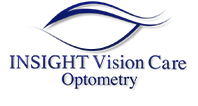We’re all guilty of it, those extra hours spent scrolling through our phones, binge-watching on the TV, or working tirelessly on our laptops. After all, screens have become an inseparable part of our day-to-day life. However, it’s important to remember that prolonged screen exposure can affect our eyes and disrupt our sleep routine, primarily due to blue light emission.
Fortunately, there’s a useful tool, blue light glasses. You can wear blue light glasses all day without causing harm, especially if you spend a lot of time looking at screens. These glasses are designed to filter out blue light from digital devices, which can help with fatigue, concentration and trouble falling asleep.
However, they aren’t a substitute for a proper prescription if you need vision correction. If you’re curious whether blue light glasses are right for you or need an updated prescription, book an eye exam with Insight Vision Care Optometry.
So, What Exactly Is Blue Light?
Blue light is part of the visible light spectrum, characterized by shorter wavelengths that produce higher energy compared to other colors. Naturally, it’s all around us, with the sun being the primary source of blue light. It plays an essential role in regulating our circadian rhythm, helping us feel alert during the day.
However, in today’s digital age, artificial sources of blue light have significantly increased our exposure. Devices like smartphones, computers, and TVs emit blue light, often at levels that can affect eye health and sleep patterns.
Additionally, common lighting sources such as fluorescent and LED lights in homes and offices contribute to the growing levels of blue light exposure, making it nearly impossible to avoid in daily life.
How Does Blue Light Affect Us?
The rise of digitalisation has dramatically increased our exposure to blue light. While blue light has its benefits, boosting alertness, improving cognitive function, and helping regulate our sleep-wake cycle, overexposure can pose serious challenges.
Blue light suppresses melatonin, the hormone essential for sleep, which can disrupt our ability to rest and recharge. This disruption may lead to:
- Sleep disturbances
- Daytime fatigue
- Trouble concentrating
- Mood swings
- Heightened risk of mental health issues
Fortunately, you can protect yourself by adopting strategies like limiting screen time and taking proactive preventive measures like wearing blue light glasses.
Introducing Blue Light Glasses
Blue light glasses are an eyewear solution designed to filter out blue light from screens and surroundings. Unique from regular glasses, they feature lenses that effectively absorb or block blue light, thereby protecting your eyes.
These glasses offer features including anti-reflective coatings, slightly tinted lenses, lightweight frames, and scratch-resistant lenses providing you with much-needed comfort during extended usage.
When & Where Should You Wear Blue Light Glasses?

The optimal time to use blue light glasses is any time you’re around screens. They’re your best bet if you’re using a computer or any digital device for work. Even in spaces with LED or fluorescent lights, these glasses can come in handy.
Ideally, wearing these glasses in the afternoon or evening, particularly around your screen time before bed, can help curb your exposure to blue light, thereby enhancing your sleep routine and reducing melatonin suppression risk.
Can Blue Light Glasses Cause Any Side Effects?
Blue light glasses are generally safe to use and don’t cause harmful side effects for most people. However, as with any eyewear, some people might experience mild discomfort during initial use, such as slight eye strain or a minor adjustment period as their eyes adapt to the new lenses.
Additionally, wearing blue light glasses with excessively high tint levels in non-digital environments may make vision feel unnatural or darker. To avoid these issues, ensure that you choose a high-quality pair of glasses and use them appropriately. If discomfort persists, it’s always a good idea to consult an eye care professional.
Additional Ways to Stay Comfortable While Using Digital Devices
- Ergonomics
Proper ergonomics can significantly reduce discomfort while using digital devices. Ensure your chair provides adequate lower back support and adjust it so your feet are flat on the ground. Position your screen at eye level and about an arm’s length away to minimize neck and eye strain. Using an adjustable desk can also help you maintain a healthy posture throughout the day.
- Settings
Optimize the settings on your device to reduce strain on your eyes. Adjust the screen brightness to match the lighting in your environment, and enable features such as night mode or blue light filters, which can help minimize the impact of blue light exposure. Customizing text size and contrast can also improve readability and reduce eye fatigue.
- Lighting Levels
Proper lighting plays an important role in reducing eye strain. Avoid glare by positioning your screen away from windows or overhead lights, and use softer, indirect lighting in your workspace. A desk lamp with adjustable brightness can help balance light levels without creating unnecessary reflections on your screen.
- The 20-20-20 Rule
The 20-20-20 rule is an easy-to-follow guideline to reduce eye strain. Every 20 minutes, take a 20-second break to look at something 20 feet away. This practice helps your eyes refocus and relax, preventing prolonged stress caused by staring at a screen for long periods. Setting reminders or using dedicated apps can make it easier to incorporate this habit into your routine.
Securing Your Pair of Blue Light Glasses
Blue light glasses can be a helpful addition to your daily routine if you spend a lot of time looking at screens. They’re designed to filter out blue light, which can improve comfort and help you sleep better.
Ready to protect your eyes from blue light and keep your vision sharp? Request an appointment with Insight Vision Care Optometry.



